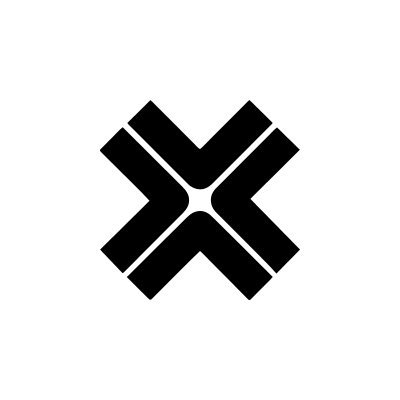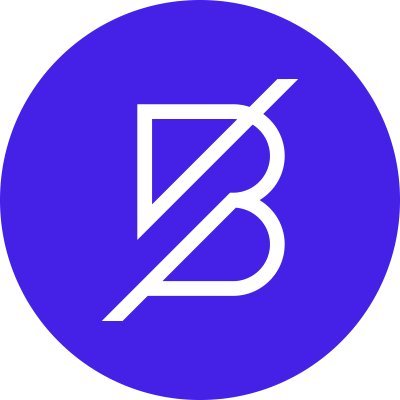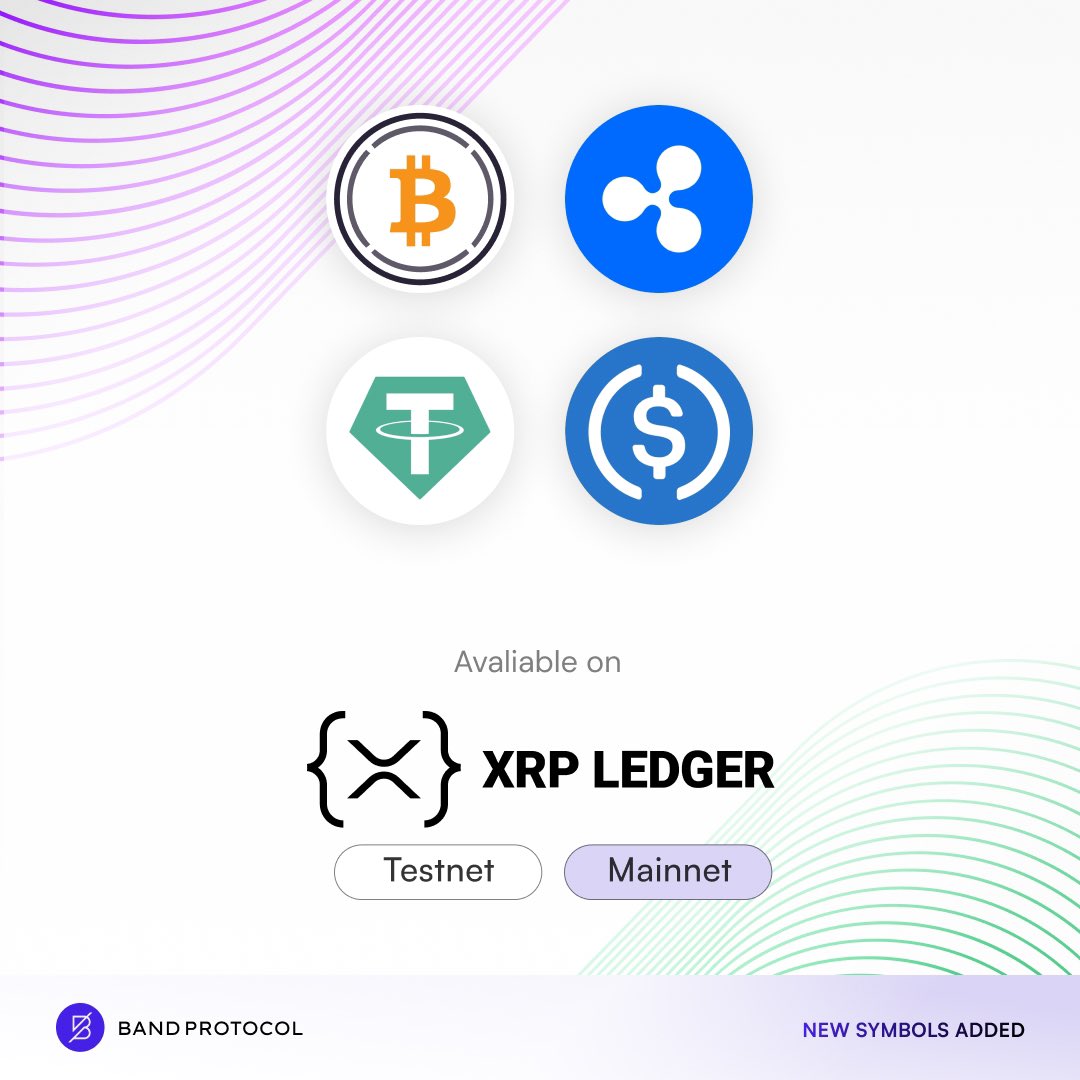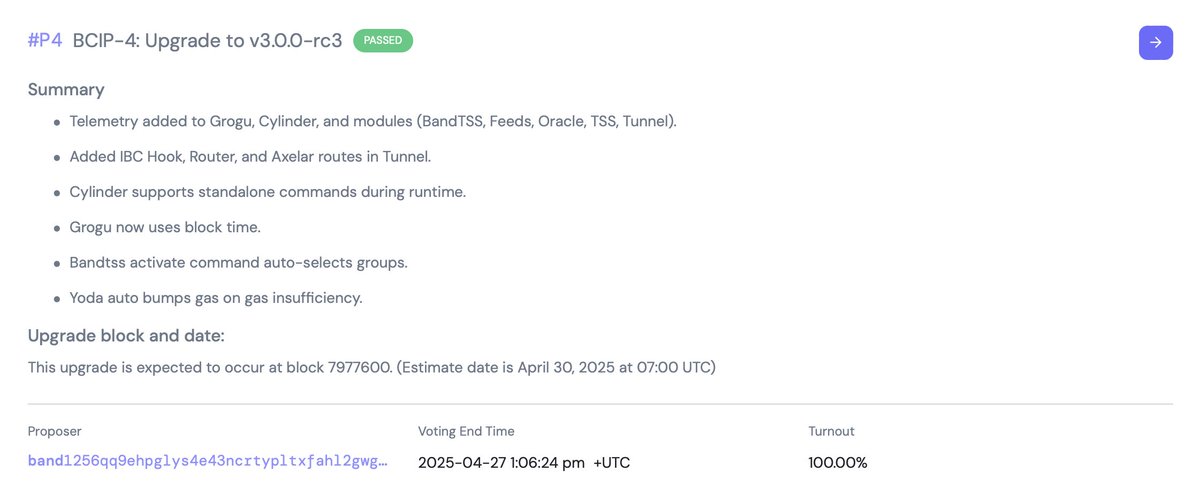
BAND
Band Protocol-pris
$0,79850
-$0,04610
(−5,46 %)
Prisändring från 00.00 UTC fram till nu

Hur känner du för BAND idag?
Dela dina känslor här genom att göra tummen upp om du känner dig bullish för coin eller tummen ner om du känner dig bearish.
Rösta för att visa resultat
Friskrivningsklausul
Det sociala innehållet på den här sidan ("Innehållet"), inklusive men inte begränsat till tweets och statistik som tillhandahålls av LunarCrush, kommer från tredje part och tillhandahålls " i befintligt skick" och endast i informationssyfte. OKX garanterar inte innehållets kvalitet eller sanningshalt, och innehållet representerar inte OKX:s åsikter. Det är inte avsett att tillhandahålla (i) investeringsrådgivning eller -rekommendationer; (ii) ett erbjudande eller en uppmaning att köpa, sälja eller inneha digitala tillgångar; eller (iii) finansiell, redovisnings-, juridisk eller skatterådgivning. Digitala tillgångar, inklusive stabil kryptovaluta och NFT:er, innebär en hög grad av risk och kan fluktuera kraftigt. Priset och prestandan för den digitala tillgången är inte garanterade och kan ändras utan föregående meddelande.
OKX tillhandahåller inga rekommendationer om investeringar eller tillgångar. Du bör noga överväga om handel eller innehav av digitala tillgångar är lämpligt för dig, med tanke på din ekonomiska situation. Vänligen rådfråga en juridisk-/skatte-/investeringsrådgivare för frågor om just dina specifika omständigheter. För mer information, vänligen se våra Användarvillkor och Riskvarning. Genom att använda tredjepartswebbplatsen (”third-party website/TPW”) godkänner du att all användning av TPW kommer att omfattas av och regleras av villkoren i TPW. Om inte annat uttryckligen anges skriftligen är OKX och dess dotterbolag ( OKX ) inte på något sätt associerade med ägaren eller operatören av TPW. Du samtycker till att OKX inte är ansvarigt eller skyldigt för någon förlust, skada eller andra konsekvenser som uppstår på grund av din användning av TPW. Vänligen observera om att användning av en TPW kan resultera i förlust eller minskning av dina tillgångar. Produkten kanske inte är tillgänglig i alla jurisdiktioner.
OKX tillhandahåller inga rekommendationer om investeringar eller tillgångar. Du bör noga överväga om handel eller innehav av digitala tillgångar är lämpligt för dig, med tanke på din ekonomiska situation. Vänligen rådfråga en juridisk-/skatte-/investeringsrådgivare för frågor om just dina specifika omständigheter. För mer information, vänligen se våra Användarvillkor och Riskvarning. Genom att använda tredjepartswebbplatsen (”third-party website/TPW”) godkänner du att all användning av TPW kommer att omfattas av och regleras av villkoren i TPW. Om inte annat uttryckligen anges skriftligen är OKX och dess dotterbolag ( OKX ) inte på något sätt associerade med ägaren eller operatören av TPW. Du samtycker till att OKX inte är ansvarigt eller skyldigt för någon förlust, skada eller andra konsekvenser som uppstår på grund av din användning av TPW. Vänligen observera om att användning av en TPW kan resultera i förlust eller minskning av dina tillgångar. Produkten kanske inte är tillgänglig i alla jurisdiktioner.
Band Protocol marknadsinfo
Marknadsvärde
Marknadsvärde beräknas genom att multiplicera det cirkulerande utbudet av ett coin med dess senaste pris.
Börsvärde = Cirkulerande utbud × Senaste pris
Börsvärde = Cirkulerande utbud × Senaste pris
Cirkulerande utbud
Totalt belopp för ett coin som är allmänt tillgängligt på marknaden.
Marknadsvärde-rankning
Ett coins rankning i termer av marknadsvärde.
Högsta någonsin
Högsta pris ett coin har nått i sin handelshistorik.
Lägsta någonsin
Lägsta pris ett coin har nått i sin handelshistorik.
Marknadsvärde
$124,44M
Cirkulerande utbud
155 942 921 BAND
97,20 % av
160 433 581 BAND
Marknadsvärde-rankning
--
Granskningar

Senaste granskningen: 1 aug. 2019
Högsta priset under 24 tim
$0,84530
Lägsta priset under 24 tim
$0,78910
Högsta någonsin
$23,3270
−96,58 % (-$22,5285)
Senast uppdaterad: 15 apr. 2021
Lägsta någonsin
$0,55070
+44,99 % (+$0,24780)
Senast uppdaterad: 7 apr. 2025
Band Protocol-flödet
Följande innehåll är hämtat från .

Axelar Network delade inlägget

Axelar Network
.@BandProtocol går Oracle v3 från fas 1 till fas 2 och blir snabbare och kraftfullare än någonsin tidigare.
Med nya Data Tunnel-rutter som är live, går deras orakel över flera kedjor med Axelar som driver crosschain-verifierade 🔑 🌐 flöden

Band Protocol
Idag har vi framgångsrikt lanserat Band Oracle v3 Testnet Phase 2 – vår största uppgradering hittills.
Den här versionen gör BandChain snabbare, mer transparent och mer interoperabel än någonsin.
Låt oss bryta ner vad som är nytt👇
Vad uppnådde vi?
- 3x snabbare blocktid från 3s —> 1s
- 10x symboler keps expanderas från 100 —> 300 symboler
- 10x högre genomströmning: 40k till 400k TX/dag
- 3x Max TXs support/dag: 7.2 miljoner TXs —> 21.6 M TXs
🌐 Nya datatunnelrutter är LIVE
Vi utökar Bands orakelräckvidd över hela världen med flera kedjor:
—> @cosmos's IBC-Hook: sömlös kontraktsförfrågan mellan kedjor
—> @routerprotocol: Överbryggnings- och EVM-kedjor och snart på @Solana
—> @axelar: Pågående samarbete för cross-chain-verifierade flöden
Interoperabilitet är inte längre en önskelista – den är verklig.
🛠️ Mindre uppgraderingar med stor inverkan:
— Cylinder CLI körs fristående
— Signaltiderna är nu blockbaserade (inte maskintiden)
— Välj TSS-grupper automatiskt
- Yoda stöter nu automatiskt på gas för att undvika TX-fel
— Telemetri för varaktigheter för BeginBlock/EndBlock
Det handlar om smidigare operationer för utvecklare och validerare.
🧪 Vad händer härnäst?
✅ Sammanfattning + dokument för Testnet Fas 2
✅ Mer stresstestning av datatunnel
✅ Optimeringar på backend + valideringssidan
🚀 Lansering av Mainnet under Q3 2025
Vi är nästan där.
Band Oracle v3 håller på att bli det bästa oraklet för öppna data för alla ekosystem.
Snabb. Genomskinlig. Ny standard för inbyggd multikedja.
Tack till validerarna, utvecklarna, partnerna och Band-communityt för att ni byggde detta med oss. Låt oss fortsätta.
Läs hela tillkännagivandet här:
15,96 tn
158

swit.eth #6010
🚢🚢🚢

Band Protocol
Idag har vi framgångsrikt lanserat Band Oracle v3 Testnet Phase 2 – vår största uppgradering hittills.
Den här versionen gör BandChain snabbare, mer transparent och mer interoperabel än någonsin.
Låt oss bryta ner vad som är nytt👇
Vad uppnådde vi?
- 3x snabbare blocktid från 3s —> 1s
- 10x symboler keps expanderas från 100 —> 300 symboler
- 10x högre genomströmning: 40k till 400k TX/dag
- 3x Max TXs support/dag: 7.2 miljoner TXs —> 21.6 M TXs
🌐 Nya datatunnelrutter är LIVE
Vi utökar Bands orakelräckvidd över hela världen med flera kedjor:
—> @cosmos's IBC-Hook: sömlös kontraktsförfrågan mellan kedjor
—> @routerprotocol: Överbryggnings- och EVM-kedjor och snart på @Solana
—> @axelar: Pågående samarbete för cross-chain-verifierade flöden
Interoperabilitet är inte längre en önskelista – den är verklig.
🛠️ Mindre uppgraderingar med stor inverkan:
— Cylinder CLI körs fristående
— Signaltiderna är nu blockbaserade (inte maskintiden)
— Välj TSS-grupper automatiskt
- Yoda stöter nu automatiskt på gas för att undvika TX-fel
— Telemetri för varaktigheter för BeginBlock/EndBlock
Det handlar om smidigare operationer för utvecklare och validerare.
🧪 Vad händer härnäst?
✅ Sammanfattning + dokument för Testnet Fas 2
✅ Mer stresstestning av datatunnel
✅ Optimeringar på backend + valideringssidan
🚀 Lansering av Mainnet under Q3 2025
Vi är nästan där.
Band Oracle v3 håller på att bli det bästa oraklet för öppna data för alla ekosystem.
Snabb. Genomskinlig. Ny standard för inbyggd multikedja.
Tack till validerarna, utvecklarna, partnerna och Band-communityt för att ni byggde detta med oss. Låt oss fortsätta.
Läs hela tillkännagivandet här:
4,44 tn
1

Band Protocol
Idag har vi framgångsrikt lanserat Band Oracle v3 Testnet Phase 2 – vår största uppgradering hittills.
Den här versionen gör BandChain snabbare, mer transparent och mer interoperabel än någonsin.
Låt oss bryta ner vad som är nytt👇
Vad uppnådde vi?
- 3x snabbare blocktid från 3s —> 1s
- 10x symboler keps expanderas från 100 —> 300 symboler
- 10x högre genomströmning: 40k till 400k TX/dag
- 3x Max TXs support/dag: 7.2 miljoner TXs —> 21.6 M TXs
🌐 Nya datatunnelrutter är LIVE
Vi utökar Bands orakelräckvidd över hela världen med flera kedjor:
—> @cosmos's IBC-Hook: sömlös kontraktsförfrågan mellan kedjor
—> @routerprotocol: Överbryggnings- och EVM-kedjor och snart på @Solana
—> @axelar: Pågående samarbete för cross-chain-verifierade flöden
Interoperabilitet är inte längre en önskelista – den är verklig.
🛠️ Mindre uppgraderingar med stor inverkan:
— Cylinder CLI körs fristående
— Signaltiderna är nu blockbaserade (inte maskintiden)
— Välj TSS-grupper automatiskt
- Yoda stöter nu automatiskt på gas för att undvika TX-fel
— Telemetri för varaktigheter för BeginBlock/EndBlock
Det handlar om smidigare operationer för utvecklare och validerare.
🧪 Vad händer härnäst?
✅ Sammanfattning + dokument för Testnet Fas 2
✅ Mer stresstestning av datatunnel
✅ Optimeringar på backend + valideringssidan
🚀 Lansering av Mainnet under Q3 2025
Vi är nästan där.
Band Oracle v3 håller på att bli det bästa oraklet för öppna data för alla ekosystem.
Snabb. Genomskinlig. Ny standard för inbyggd multikedja.
Tack till validerarna, utvecklarna, partnerna och Band-communityt för att ni byggde detta med oss. Låt oss fortsätta.
Läs hela tillkännagivandet här:
Visa original21,2 tn
71
BAND-kalkylator


Band Protocol-prisresultat i USD
Aktuellt pris på Band Protocol är $0,79850. Sedan 00.00 UTC har Band Protocol minskade med −5,46 %. Det har för närvarande ett cirkulerande utbud av 155 942 921 BAND och ett maximalt utbud av 160 433 581 BAND, vilket ger ett marknadsvärde efter full utspädning på $124,44M. För tillfället innehar Band Protocol-coin position 0 i marknadsvärdesrankningar. Band Protocol/USD-priset uppdateras i realtid.
Idag
-$0,04610
−5,46 %
7 dagar
-$0,06500
−7,53 %
30 dagar
+$0,12110
+17,87 %
3 månader
-$0,20950
−20,79 %
Populära Band Protocol-omvandlingar
Senast uppdaterad: 2025-05-04 06:32
| 1 BAND till USD | 0,79800 $ |
| 1 BAND till EUR | 0,70603 € |
| 1 BAND till PHP | 44,4191 ₱ |
| 1 BAND till IDR | 13 146,62 Rp |
| 1 BAND till GBP | 0,60113 £ |
| 1 BAND till CAD | 1,1029 $ |
| 1 BAND till AED | 2,9311 AED |
| 1 BAND till VND | 20 754,23 ₫ |
Om Band Protocol (BAND)
Betyget som anges är ett sammanställt betyg som inhämtats av OKX från källorna som anges, och det anges endast för informativa syften. OKX garanterar inte betygens kvalitet eller korrekthet. Det är inte avsett att utgöra (i) investeringsrådgivning eller rekommendation, (ii) ett erbjudande eller en uppmaning att köpa, sälja eller inneha digitala tillgångar, eller (iii) finansiell, redovisningsmässig, juridisk eller skattemässig rådgivning. Digitala tillgångar, inklusive stabil kryptovaluta och NFT:er, omfattas av hög risk, kan skifta kraftigt och till och med bli värdelösa. Priset och prestanda för de digitala tillgångarna garanteras inte, och de kan förändras utan föregående meddelande. Dina digitala tillgångar täcks inte av försäkran mot potentiella förluster. Historisk avkastning är ingen garanti om framtida avkastning. OKX garanterar inte någon avkastning, återbetalning av huvudbelopp eller ränta. OKX tillhandahåller inga rekommendationer om investeringar eller tillgångar. Du bör noga överväga om handel med eller innehav av digitala tillgångar är lämpligt för dig med hänsyn till din ekonomiska situation. Rådgör med din jurist, skatteexpert eller investeringsrådgivare om du har frågor om dina specifika omständigheter.
Visa mer
- Officiell webbplats
- Vitbok
- Github
- Block explorer
Om tredjeparts webbplatser
Om tredjeparts webbplatser
Genom att använda tredjepartswebbplatsen (”TPW”) samtycker du till att all användning av TPW kommer att omfattas av och styras av villkoren i TPW. Om inte annat uttryckligen anges skriftligen är OKX och dess affiliates (”OKX”) inte på något sätt associerade med ägaren eller operatören av TPW. Du samtycker till att OKX inte är ansvarigt eller skadeståndsskyldigt för förlust, skada eller andra konsekvenser som uppstår till följd av din användning av TPW. Var medveten om att användning av en TPW kan leda till förlust eller minskning av dina tillgångar.
Vanliga frågor för Band Protocol
Hur mycket är 1 Band Protocol värd idag?
För närvarande är en Band Protocol värd $0,79850. För svar och insikt om prisåtgärder för Band Protocol är du på rätt plats. Utforska de senaste diagrammen för Band Protocol och handla ansvarsfullt med OKX.
Vad är kryptovalutor?
Kryptovalutor, till exempel Band Protocol, är digitala tillgångar som fungerar på en offentlig reskontra som kallas blockkedjor. Läs mer om coins och tokens som erbjuds på OKX och deras olika attribut, som inkluderar live-priser och realtidsdiagram.
När uppfanns kryptovalutor?
Tack vare finanskrisen 2008 ökade intresset för decentraliserad finansiering. Bitcoin erbjöd en ny lösning genom att vara en säker digital tillgång på ett decentraliserat nätverk. Sedan dess har många andra tokens som t.ex. Band Protocol skapats också.
Kommer priset på Band Protocol gå upp idag?
Se vår Band Protocol prisprognossida för att förutse framtida priser och fastställa dina prismål.
ESG-upplysning
ESG-regleringar (Environmental, Social och Governance) för kryptotillgångar syftar till att ta itu med eventuell miljöpåverkan (t.ex. energiintensiv mining), främja transparens och säkerställa etiska förvaltningsmetoder för att anpassa kryptoindustrin till bredare hållbarhets- och samhälleliga mål. Dessa regleringar uppmuntrar efterlevnad av standarder som minskar risker och främjar förtroende för digitala tillgångar.
Tillgångsdetaljer
Namn
OKcoin Europe LTD
Relevant juridisk enhetsidentifierare
54930069NLWEIGLHXU42
Namn på kryptotillgången
Band Protocol
Konsensusmekanism
Band Protocol is present on the following networks: binance_smart_chain, ethereum, fantom, gnosis_chain.
Binance Smart Chain (BSC) uses a hybrid consensus mechanism called Proof of Staked Authority (PoSA), which combines elements of Delegated Proof of Stake (DPoS) and Proof of Authority (PoA). This method ensures fast block times and low fees while maintaining a level of decentralization and security. Core Components 1. Validators (so-called “Cabinet Members”): Validators on BSC are responsible for producing new blocks, validating transactions, and maintaining the network’s security. To become a validator, an entity must stake a significant amount of BNB (Binance Coin). Validators are selected through staking and voting by token holders. There are 21 active validators at any given time, rotating to ensure decentralization and security. 2. Delegators: Token holders who do not wish to run validator nodes can delegate their BNB tokens to validators. This delegation helps validators increase their stake and improves their chances of being selected to produce blocks. Delegators earn a share of the rewards that validators receive, incentivizing broad participation in network security. 3. Candidates: Candidates are nodes that have staked the required amount of BNB and are in the pool waiting to become validators. They are essentially potential validators who are not currently active but can be elected to the validator set through community voting. Candidates play a crucial role in ensuring there is always a sufficient pool of nodes ready to take on validation tasks, thus maintaining network resilience and decentralization. Consensus Process 4. Validator Selection: Validators are chosen based on the amount of BNB staked and votes received from delegators. The more BNB staked and votes received, the higher the chance of being selected to validate transactions and produce new blocks. The selection process involves both the current validators and the pool of candidates, ensuring a dynamic and secure rotation of nodes. 5. Block Production: The selected validators take turns producing blocks in a PoA-like manner, ensuring that blocks are generated quickly and efficiently. Validators validate transactions, add them to new blocks, and broadcast these blocks to the network. 6. Transaction Finality: BSC achieves fast block times of around 3 seconds and quick transaction finality. This is achieved through the efficient PoSA mechanism that allows validators to rapidly reach consensus. Security and Economic Incentives 7. Staking: Validators are required to stake a substantial amount of BNB, which acts as collateral to ensure their honest behavior. This staked amount can be slashed if validators act maliciously. Staking incentivizes validators to act in the network's best interest to avoid losing their staked BNB. 8. Delegation and Rewards: Delegators earn rewards proportional to their stake in validators. This incentivizes them to choose reliable validators and participate in the network’s security. Validators and delegators share transaction fees as rewards, which provides continuous economic incentives to maintain network security and performance. 9. Transaction Fees: BSC employs low transaction fees, paid in BNB, making it cost-effective for users. These fees are collected by validators as part of their rewards, further incentivizing them to validate transactions accurately and efficiently.
The Ethereum network uses a Proof-of-Stake Consensus Mechanism to validate new transactions on the blockchain. Core Components 1. Validators: Validators are responsible for proposing and validating new blocks. To become a validator, a user must deposit (stake) 32 ETH into a smart contract. This stake acts as collateral and can be slashed if the validator behaves dishonestly. 2. Beacon Chain: The Beacon Chain is the backbone of Ethereum 2.0. It coordinates the network of validators and manages the consensus protocol. It is responsible for creating new blocks, organizing validators into committees, and implementing the finality of blocks. Consensus Process 1. Block Proposal: Validators are chosen randomly to propose new blocks. This selection is based on a weighted random function (WRF), where the weight is determined by the amount of ETH staked. 2. Attestation: Validators not proposing a block participate in attestation. They attest to the validity of the proposed block by voting for it. Attestations are then aggregated to form a single proof of the block’s validity. 3. Committees: Validators are organized into committees to streamline the validation process. Each committee is responsible for validating blocks within a specific shard or the Beacon Chain itself. This ensures decentralization and security, as a smaller group of validators can quickly reach consensus. 4. Finality: Ethereum 2.0 uses a mechanism called Casper FFG (Friendly Finality Gadget) to achieve finality. Finality means that a block and its transactions are considered irreversible and confirmed. Validators vote on the finality of blocks, and once a supermajority is reached, the block is finalized. 5. Incentives and Penalties: Validators earn rewards for participating in the network, including proposing blocks and attesting to their validity. Conversely, validators can be penalized (slashed) for malicious behavior, such as double-signing or being offline for extended periods. This ensures honest participation and network security.
Fantom operates on the Lachesis Protocol, an Asynchronous Byzantine Fault Tolerant (aBFT) consensus mechanism designed for fast, secure, and scalable transactions. Core Components of Fantom’s Consensus: 1. Lachesis Protocol (aBFT): Asynchronous and Leaderless: Lachesis allows nodes to reach consensus independently without relying on a central leader, enhancing decentralization and speed. DAG Structure: Instead of a linear blockchain, Lachesis uses a Directed Acyclic Graph (DAG) structure, allowing multiple transactions to be processed in parallel across nodes. This structure supports high throughput, making the network suitable for applications requiring rapid transaction processing. 2. Event Blocks and Instant Finality: Event Blocks: Transactions are grouped into event blocks, which are validated asynchronously by multiple validators. When enough validators confirm an event block, it becomes part of the Fantom network’s history. Instant Finality: Transactions on Fantom achieve immediate finality, meaning they are confirmed and cannot be reversed. This property is ideal for applications requiring fast and irreversible transactions.
Gnosis Chain – Consensus Mechanism Gnosis Chain employs a dual-layer structure to balance scalability and security, using Proof of Stake (PoS) for its core consensus and transaction finality. Core Components: Two-Layer Structure Layer 1: Gnosis Beacon Chain The Gnosis Beacon Chain operates on a Proof of Stake (PoS) mechanism, acting as the security and consensus backbone. Validators stake GNO tokens on the Beacon Chain and validate transactions, ensuring network security and finality. Layer 2: Gnosis xDai Chain Gnosis xDai Chain processes transactions and dApp interactions, providing high-speed, low-cost transactions. Layer 2 transaction data is finalized on the Gnosis Beacon Chain, creating an integrated framework where Layer 1 ensures security and finality, and Layer 2 enhances scalability. Validator Role and Staking Validators on the Gnosis Beacon Chain stake GNO tokens and participate in consensus by validating blocks. This setup ensures that validators have an economic interest in maintaining the security and integrity of both the Beacon Chain (Layer 1) and the xDai Chain (Layer 2). Cross-Layer Security Transactions on Layer 2 are ultimately finalized on Layer 1, providing security and finality to all activities on the Gnosis Chain. This architecture allows Gnosis Chain to combine the speed and cost efficiency of Layer 2 with the security guarantees of a PoS-secured Layer 1, making it suitable for both high-frequency applications and secure asset management.
Incitamentmekanismer och tillämpliga avgifter
Band Protocol is present on the following networks: binance_smart_chain, ethereum, fantom, gnosis_chain.
Binance Smart Chain (BSC) uses the Proof of Staked Authority (PoSA) consensus mechanism to ensure network security and incentivize participation from validators and delegators. Incentive Mechanisms 1. Validators: Staking Rewards: Validators must stake a significant amount of BNB to participate in the consensus process. They earn rewards in the form of transaction fees and block rewards. Selection Process: Validators are selected based on the amount of BNB staked and the votes received from delegators. The more BNB staked and votes received, the higher the chances of being selected to validate transactions and produce new blocks. 2. Delegators: Delegated Staking: Token holders can delegate their BNB to validators. This delegation increases the validator's total stake and improves their chances of being selected to produce blocks. Shared Rewards: Delegators earn a portion of the rewards that validators receive. This incentivizes token holders to participate in the network’s security and decentralization by choosing reliable validators. 3. Candidates: Pool of Potential Validators: Candidates are nodes that have staked the required amount of BNB and are waiting to become active validators. They ensure that there is always a sufficient pool of nodes ready to take on validation tasks, maintaining network resilience. 4. Economic Security: Slashing: Validators can be penalized for malicious behavior or failure to perform their duties. Penalties include slashing a portion of their staked tokens, ensuring that validators act in the best interest of the network. Opportunity Cost: Staking requires validators and delegators to lock up their BNB tokens, providing an economic incentive to act honestly to avoid losing their staked assets. Fees on the Binance Smart Chain 5. Transaction Fees: Low Fees: BSC is known for its low transaction fees compared to other blockchain networks. These fees are paid in BNB and are essential for maintaining network operations and compensating validators. Dynamic Fee Structure: Transaction fees can vary based on network congestion and the complexity of the transactions. However, BSC ensures that fees remain significantly lower than those on the Ethereum mainnet. 6. Block Rewards: Incentivizing Validators: Validators earn block rewards in addition to transaction fees. These rewards are distributed to validators for their role in maintaining the network and processing transactions. 7. Cross-Chain Fees: Interoperability Costs: BSC supports cross-chain compatibility, allowing assets to be transferred between Binance Chain and Binance Smart Chain. These cross-chain operations incur minimal fees, facilitating seamless asset transfers and improving user experience. 8. Smart Contract Fees: Deployment and Execution Costs: Deploying and interacting with smart contracts on BSC involves paying fees based on the computational resources required. These fees are also paid in BNB and are designed to be cost-effective, encouraging developers to build on the BSC platform.
Ethereum, particularly after transitioning to Ethereum 2.0 (Eth2), employs a Proof-of-Stake (PoS) consensus mechanism to secure its network. The incentives for validators and the fee structures play crucial roles in maintaining the security and efficiency of the blockchain. Incentive Mechanisms 1. Staking Rewards: Validator Rewards: Validators are essential to the PoS mechanism. They are responsible for proposing and validating new blocks. To participate, they must stake a minimum of 32 ETH. In return, they earn rewards for their contributions, which are paid out in ETH. These rewards are a combination of newly minted ETH and transaction fees from the blocks they validate. Reward Rate: The reward rate for validators is dynamic and depends on the total amount of ETH staked in the network. The more ETH staked, the lower the individual reward rate, and vice versa. This is designed to balance the network's security and the incentive to participate. 2. Transaction Fees: Base Fee: After the implementation of Ethereum Improvement Proposal (EIP) 1559, the transaction fee model changed to include a base fee that is burned (i.e., removed from circulation). This base fee adjusts dynamically based on network demand, aiming to stabilize transaction fees and reduce volatility. Priority Fee (Tip): Users can also include a priority fee (tip) to incentivize validators to include their transactions more quickly. This fee goes directly to the validators, providing them with an additional incentive to process transactions efficiently. 3. Penalties for Malicious Behavior: Slashing: Validators face penalties (slashing) if they engage in malicious behavior, such as double-signing or validating incorrect information. Slashing results in the loss of a portion of their staked ETH, discouraging bad actors and ensuring that validators act in the network's best interest. Inactivity Penalties: Validators also face penalties for prolonged inactivity. This ensures that validators remain active and engaged in maintaining the network's security and operation. Fees Applicable on the Ethereum Blockchain 1. Gas Fees: Calculation: Gas fees are calculated based on the computational complexity of transactions and smart contract executions. Each operation on the Ethereum Virtual Machine (EVM) has an associated gas cost. Dynamic Adjustment: The base fee introduced by EIP-1559 dynamically adjusts according to network congestion. When demand for block space is high, the base fee increases, and when demand is low, it decreases. 2. Smart Contract Fees: Deployment and Interaction: Deploying a smart contract on Ethereum involves paying gas fees proportional to the contract's complexity and size. Interacting with deployed smart contracts (e.g., executing functions, transferring tokens) also incurs gas fees. Optimizations: Developers are incentivized to optimize their smart contracts to minimize gas usage, making transactions more cost-effective for users. 3. Asset Transfer Fees: Token Transfers: Transferring ERC-20 or other token standards involves gas fees. These fees vary based on the token's contract implementation and the current network demand.
Fantom’s incentive model promotes network security through staking rewards, transaction fees, and delegation options, encouraging broad participation. Incentive Mechanisms: 1. Staking Rewards for Validators: Earning Rewards in FTM: Validators who participate in the consensus process earn rewards in FTM tokens, proportional to the amount they have staked. This incentivizes validators to actively secure the network. Dynamic Staking Rate: Fantom’s staking reward rate is dynamic, adjusting based on total FTM staked across the network. As more FTM is staked, individual rewards may decrease, maintaining a balanced reward structure that supports long-term network security. 2. Delegation for Token Holders: Delegated Staking: Users who do not operate validator nodes can delegate their FTM tokens to validators. In return, they share in the staking rewards, encouraging wider participation in securing the network. Applicable Fees: • Transaction Fees in FTM: Users pay transaction fees in FTM tokens. The network’s high throughput and DAG structure keep fees low, making Fantom ideal for decentralized applications (dApps) requiring frequent transactions. • Efficient Fee Model: The low fees and scalability of the network make it cost-effective for users, fostering a favorable environment for high-volume applications.
The Gnosis Chain’s incentive and fee models encourage both validator participation and network accessibility, using a dual-token system to maintain low transaction costs and effective staking rewards. Incentive Mechanisms: Staking Rewards for Validators GNO Rewards: Validators earn staking rewards in GNO tokens for their participation in consensus and securing the network. Delegation Model: GNO holders who do not operate validator nodes can delegate their GNO tokens to validators, allowing them to share in staking rewards and encouraging broader participation in network security. Dual-Token Model GNO: Used for staking, governance, and validator rewards, GNO aligns long-term network security incentives with token holders’ economic interests. xDai: Serves as the primary transaction currency, providing stable and low-cost transactions. The use of a stable token (xDai) for fees minimizes volatility and offers predictable costs for users and developers. Applicable Fees: Transaction Fees in xDai Users pay transaction fees in xDai, the stable fee token, making costs affordable and predictable. This model is especially suited for high-frequency applications and dApps where low transaction fees are essential. xDai transaction fees are redistributed to validators as part of their compensation, aligning their rewards with network activity. Delegated Staking Rewards Through delegated staking, GNO holders can earn a share of staking rewards by delegating their tokens to active validators, promoting user participation in network security without requiring direct involvement in consensus operations.
Början av den period som upplysningen avser
2024-04-20
Slutet av den period som upplysningen avser
2025-04-20
Energirapport
Energiförbrukning
162.77534 (kWh/a)
Energiförbrukningskällor och -metoder
The energy consumption of this asset is aggregated across multiple components:
To determine the energy consumption of a token, the energy consumption of the network(s) binance_smart_chain, ethereum, fantom, gnosis_chain is calculated first. Based on the crypto asset's gas consumption per network, the share of the total consumption of the respective network that is assigned to this asset is defined. When calculating the energy consumption, we used - if available - the Functionally Fungible Group Digital Token Identifier (FFG DTI) to determine all implementations of the asset of question in scope and we update the mappings regulary, based on data of the Digital Token Identifier Foundation.
BAND-kalkylator


Friskrivningsklausul
Det sociala innehållet på den här sidan ("Innehållet"), inklusive men inte begränsat till tweets och statistik som tillhandahålls av LunarCrush, kommer från tredje part och tillhandahålls " i befintligt skick" och endast i informationssyfte. OKX garanterar inte innehållets kvalitet eller sanningshalt, och innehållet representerar inte OKX:s åsikter. Det är inte avsett att tillhandahålla (i) investeringsrådgivning eller -rekommendationer; (ii) ett erbjudande eller en uppmaning att köpa, sälja eller inneha digitala tillgångar; eller (iii) finansiell, redovisnings-, juridisk eller skatterådgivning. Digitala tillgångar, inklusive stabil kryptovaluta och NFT:er, innebär en hög grad av risk och kan fluktuera kraftigt. Priset och prestandan för den digitala tillgången är inte garanterade och kan ändras utan föregående meddelande.
OKX tillhandahåller inga rekommendationer om investeringar eller tillgångar. Du bör noga överväga om handel eller innehav av digitala tillgångar är lämpligt för dig, med tanke på din ekonomiska situation. Vänligen rådfråga en juridisk-/skatte-/investeringsrådgivare för frågor om just dina specifika omständigheter. För mer information, vänligen se våra Användarvillkor och Riskvarning. Genom att använda tredjepartswebbplatsen (”third-party website/TPW”) godkänner du att all användning av TPW kommer att omfattas av och regleras av villkoren i TPW. Om inte annat uttryckligen anges skriftligen är OKX och dess dotterbolag ( OKX ) inte på något sätt associerade med ägaren eller operatören av TPW. Du samtycker till att OKX inte är ansvarigt eller skyldigt för någon förlust, skada eller andra konsekvenser som uppstår på grund av din användning av TPW. Vänligen observera om att användning av en TPW kan resultera i förlust eller minskning av dina tillgångar. Produkten kanske inte är tillgänglig i alla jurisdiktioner.
OKX tillhandahåller inga rekommendationer om investeringar eller tillgångar. Du bör noga överväga om handel eller innehav av digitala tillgångar är lämpligt för dig, med tanke på din ekonomiska situation. Vänligen rådfråga en juridisk-/skatte-/investeringsrådgivare för frågor om just dina specifika omständigheter. För mer information, vänligen se våra Användarvillkor och Riskvarning. Genom att använda tredjepartswebbplatsen (”third-party website/TPW”) godkänner du att all användning av TPW kommer att omfattas av och regleras av villkoren i TPW. Om inte annat uttryckligen anges skriftligen är OKX och dess dotterbolag ( OKX ) inte på något sätt associerade med ägaren eller operatören av TPW. Du samtycker till att OKX inte är ansvarigt eller skyldigt för någon förlust, skada eller andra konsekvenser som uppstår på grund av din användning av TPW. Vänligen observera om att användning av en TPW kan resultera i förlust eller minskning av dina tillgångar. Produkten kanske inte är tillgänglig i alla jurisdiktioner.













